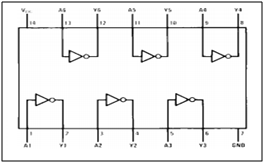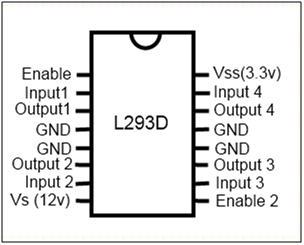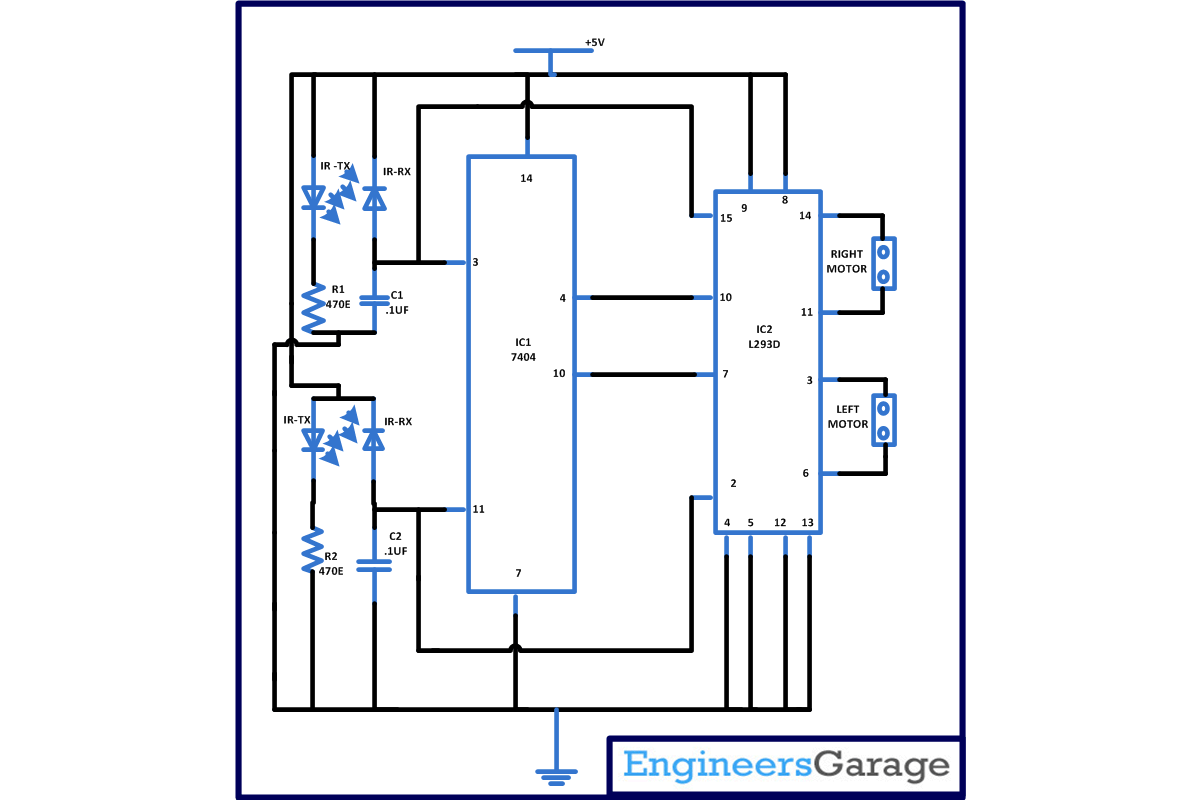This circuit describe a simple obstacle avoiding robot which a you can easily make in your homes because it does not contains any complex digital circuitry and this can be made without using any microcontroller. This is an intelligent robot which will automatically detect the presence of obstacle in its path and change the direction of motion accordingly.
[[wysiwyg_imageupload:11703:]]
Fig. 1: Prototype of Obstacle Avoiding Robot Circuit on Breadboard
This simple circuit is based on two IC namely 7404 and L293D with few more commonly available components. In this circuit we are using IR transmitter and receiver as a sensor to detect the obstruction.
Mostly color of IR transmitter and receiver is different but sometimes color of both IR transmitter and receiver is same at that time you should be careful while using it in the circuit. If they are wrongly place than your circuit will not work. You can distinguish the IR transmitter and receiver by simple following steps with the help of multimeter.
1. First of all set the multimeter in 2M ohm range.
2. Pick one of them and connect cathode of that to positive terminal of multimeter.
3. And connect the anode with the negative terminal of multimeter.
4. Do the same with both the IR transmitter and receiver.
5. Now check the reading of multimeter. If reading fall in the range of few hundred kilo ohms than it is an IR receiver. And if reading in the multimeter is not indicated it means it an IR transmitter. CD7404 is a NOT or inverter gate IC. in this we are utilizing only 2 gate of IC and rest are not used. To understand the working you should know about the truth table of NOT gate are as follows-
|
|
|
|
Input |
Output |
|
0 |
1 |
|
1 |
0 |
In NOT gate we will get output as logic high when logic zero is provided and we will get logic zero when logic1 is provided in input.
CD7404 contain six inverter gates in one package as shown in diagram. In this pin 1 is input and 2 is for output for first gate similarly pin 3 is input and pin 4 is output for second gate similarly we have four more gate. In this 14 is for supply voltage and pin 7 is connected to ground.

Fig. 2: Pin Diagram of CD7404
L293D- It is a motor driver IC which is used to drive the motor on either direction. L293D comes in 16 pin dual inline package. And can drive two sets of DC motor with the help of single IC which can be move independently according to the input provided. It works on the theory of H bridge which permit voltage to flow in either direction in clockwise or anti clockwise direction. Pin diagram of L293D is as follows-

Fig. 3: Pin Diagram of L293D
From the pin diagram you can see that it has two enable pin that is pin 1 and pin 9. For rotating the DC motor enable pin should be high. For example if you want to rotate the left motor than enable pin 1 should be high. Similarly for right motor pin 9 should be high. And if any of the pin is low than that motor will not work and if both the pins are low robot will stop moving.
L293D contain four input pin 2 pin for controlling each motor. Like pin 2 and pin 7 are on left side and control the rotation of the left motor and pin 15 and pin 10 are on right side and they control the rotation of right motor. And there outputs pin are pin 3 and 6 for left motor and pin 11 and pin 14 for right motor. Following table shown below will help to you know in which direction motor will rotate when logic 0 and logic 1 is provided on the pins.
|
Pin 2 |
Pin 7 |
Motor Rotation |
|
Logic 1 |
Logic 0 |
Clockwise Direction |
|
Logic 0 |
Logic 1 |
Anticlockwise Direction |
|
Logic 0 |
Logic 0 |
No rotation |
|
Logic 1 |
Logic 1 |
No rotation |
Working of circuit
Assemble the circuit properly and connect power supply. Then robot will start moving on unobstructed path. When an object or obstacle come in between for example left IR sensor and receiver senses any obstacle then it has to turn right. In this case pin 2 of IC2 will become low and pin 7 become high and robot will change its direction. Similar phenomenon will happen when right IR sensor and receiver will receive the obstruction on its path to change the direction this can be seen from the table below. And if both the IR sensor and receiver sense the obstruction then both the motor will stop working as a result robot will also stop moving.
Be careful while powering the circuit as L293D works on 5V and it may possible motor you are using is working on 12V so provide a separate power supply for motors or use voltage regulator for providing power supply to IC’s.
Circuit Diagrams
Project Components
Filed Under: Electronic Projects



Questions related to this article?
👉Ask and discuss on Electro-Tech-Online.com and EDAboard.com forums.
Tell Us What You Think!!
You must be logged in to post a comment.